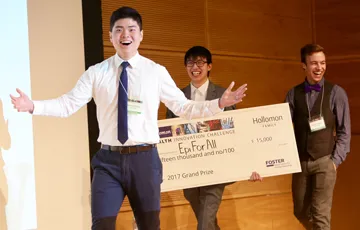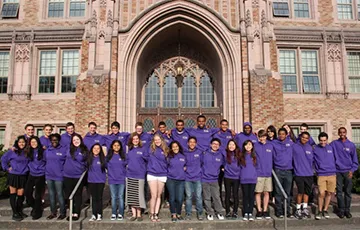News

Tue, 03/28/2017
Life on Mars?Aeronautics & Astronautics alumna Ansley Barnard, BS ’12, is one of six volunteers living in an isolated dome on the slopes of Mauna Loa on Hawaii’s Big Island, where the geology mimics that of Mars. She’s participating in a NASA-funded Mars simulation mission, known as the Hawaii Space Exploration Analog and Simulation project (HI-SEAS).

Tue, 03/28/2017 | UW Today
Parents who play ‘Pokémon GO’ with kids: ‘It wasn’t really about the Pokémon’Parents who regularly play “Pokémon GO” with their children reported a number of side benefits from playing the mobile device-based game, including increased exercise, more time spent outdoors and opportunities for family bonding, according to a team of researchers in the Department of Human Centered Design and Engineering and the Information School.

Mon, 03/27/2017 | UW Today
15 years of success for UW center in recruiting, supporting female STEM facultyOn March 31, the UW ADVANCE Center for Institutional Change will hold a 15th anniversary celebration of its work and achievements. With workshops, new resources and mentoring services the center has strived to remake the faculty recruitment and retention process. Since ADVANCE opened its doors, the UW has nearly doubled the number of female faculty in 19 STEM departments across three UW colleges.

Wed, 03/15/2017 | College of Engineering
Mindful materials: Combining love of nature with an MSE degreeMaterials Science & Engineering alum Dan Sedlacek combined his love of nature with his engineering studies to create Uphill Designs, a Seattle adventure goods company grounded in the belief that adventure is at the root of living fully.

Wed, 03/15/2017 | UW Health Sciences Newsbeat
$15 million award planned for Center for Dialysis Innovation
Seattle-based nonprofit dialysis provider Northwest Kidney Centers intends to make a $15 million grant over the next five years to support startup projects within the UW Center for Dialysis Innovation. The center, a collaboration of the UW Medicine Kidney Research Institute and UW Biomaterials/Bioengineering, is co-directed by Buddy Ratner, UW professor of bioengineering.
"Their aim is to develop revolutionary dialysis technologies, including a wearable dialysis system that is low-cost, and energy- and water-efficient. This would not only sustain users' lives, but give them more vitality and productivity. This work is desperately needed," said Joyce F. Jackson, Northwest Kidney Centers president and CEO.

Tue, 03/14/2017 | Center for Sensorimotor Neural Engineering
Neural Engineering Tech StudioThe Center for Sensorimotor Neural Engineering hosts a yearly Tech Studio course that allow students to apply engineering principles from their coursework to independent projects. At the end of the quarter, students presented their projects to CSNE industry affiliates. This year’s winning project was NEOGrasp, a low-cost neural orthosis that would allow users who are quadriplegic or tetraplegic to use another muscle to control a device that can grasp and release objects. The NEOGrasp team was composed of CSE sophomore Aishwarya Mandyam, ME Ph.D. student Gaurav Mukherjee, and BioE senior Lok "Larry” To.

Thu, 03/09/2017 | UW Today
$50M endowment establishes the Paul G. Allen School of Computer Science & Engineering at the University of WashingtonNamed for the entrepreneur, philanthropist and computing pioneer, the new Paul G. Allen School of Computer Science & Engineering recognizes Mr. Allen's longstanding support for the mission of the University and CSE. A $50 million endowment for the school will propel the UW to the forefront of computer science education and innovation for generations to come. "We are entering a new golden age of innovation in computer science, and UW students and faculty will be at its leading edge," said Allen. "My hope is that the school will have the same influence on them as it did on me — that they will continue to dream big, breaking through technological barriers and using their skills to solve some of the biggest problems our world faces."

Mon, 03/06/2017 | College of Engineering
A formula for successFor 28 years, UW Formula Motorsports has brought together students to design, build and compete formula-style vehicles. Team members credit their culture of student leadership and mentorship as key to the team’s stability and success.

Thu, 03/02/2017 | College of Engineering
Engineering student teams sweep 2017 Hollomon Health Innovation ChallengeEngineering students dominated at the 2017 Hollomon Health Innovation Challenge. First place went to ME's EpiForAll, second place to BioE's BWB Anesthesia and third place to ME's PlayGait.

Wed, 03/01/2017 | UW Today
Singing posters and talking shirts: UW engineers turn everyday objects into FM radio stations
UW researchers used FM radio signals to broadcast music and data notifications from a Simply Three band poster at a Seattle bus stop to a smartphone. An antenna made of copper tape was embedded on the back of the poster.

Tue, 02/28/2017 | UW Today
UW security researchers show that Google’s AI platform for defeating Internet trolls can be easily deceivedUniversity of Washington researchers have shown that Google’s new machine learning-based system to identify toxic comments in online discussion forums can be bypassed by simply misspelling or adding unnecessary punctuation to abusive words, such as “idiot” or “moron.”

Thu, 02/23/2017 | UW Today
UW CSE announces the Guestrin Endowed Professorship in Artificial Intelligence and Machine LearningUniversity of Washington Computer Science & Engineering announced today the establishment of the Guestrin Endowed Professorship in Artificial Intelligence and Machine Learning. This $1 million endowment will further enhance UW CSE’s ability to recruit and retain the world’s most outstanding faculty members in these burgeoning areas.

Tue, 02/21/2017 | UW Today
Three UW scientists awarded Sloan Fellowships for early-career researchAli Farhadi, assistant professor of computer science and engineering, is one of three faculty members at the University of Washington to be awarded early-career fellowships from the Alfred P. Sloan Foundation. The fellowships honor early-career scholars whose achievements mark them as the next generation of scientific leaders, and each fellow receives $60,000 to apply toward research endeavors.

Thu, 02/16/2017 | UW Today
New UW Computer Science & Engineering building receives $5M gift from Charles and Lisa SimonyiThe second Computer Science & Engineering building has received another major boost in the form of a $5 million gift from Charles & Lisa Simonyi. This gift will fund the Charles & Lisa Simonyi Undergraduate Commons, which will act as a “home away from home” for undergraduate students.

Mon, 02/13/2017 | College of Engineering
Painting by numbers: Engineering, art and data scienceCollege of Engineering spoke with alumna Susie Lu about how her unique double-major in Painting and Industrial & Systems Engineering set her on a career path to data visualization.

Fri, 02/10/2017 | UW Today
Laser-based camera developed at UW improves view of the carotid artery to assess stroke and heart attack riskA unique application of a medical camera developed by a University of Washington mechanical engineer could one day help physicians know who is at risk for a cardiovascular event by providing a better view of potential problem areas.

Fri, 02/10/2017 | UW Today
College of Engineering’s STARS program wins $2.2M to improve access for low-income students
The Washington STate Academic RedShirt (STARS) program, which offers engineering students from economically or educationally disadvantaged backgrounds extra academic support, will receive a one-time grant of $2.2 million from the Opportunity Expansion Fund passed by the Washington Legislature and funded by Microsoft.
The 3-year grant is expected to significantly increase the number of students the program can serve during that time period. The expanded STARS initiative will offer supplemental instruction in the math, chemistry and physics courses that are part of the standard engineering curriculum, as well as culturally-aware advising, professional development and career services.
Related: Led by Microsoft's Brad Smith, program gives out $6M in STEM grants in Washington (Puget Sound Business Journal) | Tech, science programs at 3 Washington universities win grants (Seattle Times)

Wed, 02/01/2017 | UW Today
New route-finding map lets Seattle pedestrians avoid hills, construction, accessibility barriers
AccessMap – a project spearheaded by the CSE-based Taskar Center for Accessible Technology – provides customized directions for Seattle pedestrians and wheelchair users looking to avoid hills, construction sites and other accessibility barriers. The online travel planner offers customizable suggestions for people who need accessible or pedestrian-friendly routes when getting from point A to B in Seattle.

Wed, 02/01/2017 | Department of Electrical Engineering
Tackling energy povertyEE alum Henry Louie founded KiloWatts for Humanity to tackle energy poverty in places like Zambia. Where few are connected to the national grid, solar- and wind-powered energy kiosks provide electricity to communities.

Wed, 01/25/2017 | Daily UW
Pod People: UW Hyperloop revs engines for SpaceXThe UW Hyperloop team makes it easy to believe that the Hyperloop is a straight shot to the future. A conceptual idea first proposed by Elon Musk in 2013, the Hyperloop uses a series of tubes to transport high-speed pods in an attempt to revolutionize transportation.

Tue, 01/24/2017 | Electrical Engineering News
Professors Majumdar and Xu Discover an Important First Step Towards Building Electrically Pumped Nano-LasersAssistant Professor of Electrical Engineering and Physics Arka Majumdar, Associate Professor of Materials Science and Engineering and Physics Xiaodong Xu and their team have discovered an important first step towards building electrically pumped nanolasers (or light-based sources). These lasers are critical in the development of integrated photonic based short-distance optical interconnects and sensors.

Thu, 01/12/2017 | UW Today
LATTICE connects women engineers in early academic careers with peers, supportLATTICE is a new national program that aims to diversify the engineering faculty population by building supportive communities during the critical transition from graduate studies to permanent tenure-track positions. Eve Riskin, associate dean of diversity and access for the College of Engineering, is co-principal investigator of LATTICE, which stands for Launching Academics on the Tenure-Track: An Intentional Community in Engineering.

Wed, 01/11/2017 | UW Today
Two UW professors win Presidential Early Career Award for Scientists and EngineersEmily Fox, associate professor of statistics and adjunct associate professor of computer science and engineering and electrical engineering, was one of two UW recipients of the 2017 Presidential Early Career Award for Scientists and Engineers, the highest honor given by the U.S. government to early career scientists and engineers. Fox was nominated by the National Science Foundation “for her groundbreaking work in large-scale Bayesian modeling and computational approaches to time series and longitudinal data analysis, and for outstanding research and mentoring of women in computer science and statistics.”

Tue, 01/10/2017 | Department of Mechanical Engineering
Passion never rests: Fethya Ibrahim’s journey through mechanical engineeringFirst in her family to attend college, Fethya Ibrahim makes the most of her time at the UW, participating in ME’s Cell Biomechanics Lab and the Machine Shop.

Tue, 01/10/2017 | UW Today
Zillow Group pledges $5 million for new UW Computer Science & Engineering buildingZillow Group committed $5 million toward the development of a second Computer Science & Engineering (CSE) building. The 130,000-square foot, state-of-the-art facility will allow the university to double the number of CSE degrees it awards each year and reduce the number of qualified students who are turned away from the program. One of the building’s highlights will be the “Zillow Commons,” a 3,000-square-foot event and multiuse space to be used by students, faculty and the community.